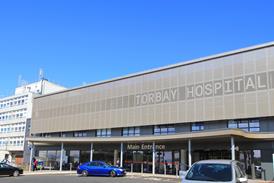Staffing is the issue keeping NHS leaders awake at night — and which consumes two-thirds of trusts’ spending. The fortnightly The Ward Round newsletter, by HSJ workforce correspondent Annabelle Collins, will make sure you are tuned in to the daily pressures on staff, and the wider trends and policies shaping the workforce. Contact me in confidence.
Hospital trusts are stuck between the devil and the deep blue sea. On one side there are growing elective waiting lists, including for some very urgent procedures. On the other side, is the need to be prepared for any further surge in covid-19 cases. How can hospitals begin to move staff and resources to “re-open” the NHS, whilst still having the flexibility to rapidly respond to another rise in coronavirus cases and a second peak?
NHS staff, in acute, community and primary care settings, had to rapidly re-adjust to re-modelled intensive rotas and new ways of working. The first phase of the restoration of non-covid services is expected to happen over the next six weeks, on a locally decided basis. In a cautious letter to the system this week, Simon Stevens set out trusts must start to “make judgements” on whether they have further capacity for routine non-urgent elective care over the next 10 days.
This means some trusts will need to think again about how to handle another redeployment of staff.
Trusts will be acutely aware rushing into another reorganisation will be difficult – especially as the health service needs to be prepared for a second covid spike. But as covid wards begin to close, particularly in some London hospitals, the health service needs to ensure it has the flexibility to respond.
As ever it is crucial to keep patient and staff safety at the forefront of the mind when moving staff around. Finn O’Dwyer-Cunliffe, NHS Providers policy advisor, stressed this was a “key measure”.
“Despite the need to act quickly, there will have to be really important safety procedures in place to ensure people are not carrying the virus to different parts of a trust,” Mr O’Dwyer-Cunliffe said.
“There is an element of patience playing it safe with how we do it to ensure a rapid turn of attention to elective treatment again doesn’t backfire,” he added.
Community pressure
In further updated staffing guidance this week NHS England said community health, primary care and mental health services were all likely to be significantly affected by the second phase of the NHS’ response to coronavirus.
With an increasing number of patients, especially older people, leaving hospital but needing often extensive intensive rehabilitation, could we see, for example, acute geriatricians being asked to support community services?
Eileen Burns, past president of the British Geriatrics Society, said geriatricians working in integrated neighbourhood community teams had in recent weeks been using their specific community time to work in acute settings instead.
“[But] as we move through [to phase two] we need to think about how we can support [the community sector] more effectively,” Dr Burns said.
“How do we deploy the scarce resource of the geriatricians between an acute hospital where covid and standard geriatric presentations are coming in and thinking and planning for geriatric input in the community,” she added.
Despite the need for community services to be bolstered to help look after patients recovering from covid, it is important that short-term fixes are not seen as part of the long-term solution. Crucial services such as health visiting must be reinstated where possible and a plan must be put in place to pick up work that hasn’t been done during the first covid peak.
Crystal Oldman, chief executive of The Queen’s Nursing Institute, stressed: “[Nurses] need to be deployed safely, this is not like moving widgets around,” Dr Oldman said. “Just because they’ve got a nurse registration doesn’t mean they can work anywhere.”
She also added there was pressure on those already in the service to support and teach newcomers.
Additional support staff
Thousands of staff signed up to re-join the NHS and help during the covid crisis. But careful thought needs to be given to their role now. It is unclear if returning staff will stay to help with a gradual increase in elective work or community care provision. One senior source suggested this simply wasn’t as compelling for some who signed up to help covid patients on the frontline.
Indeed, in NHS England’s recent guidance I referred to earlier, it acknowledged it was “high likely” providers will need additional support once services begin to restart. It warned: “Returning and additional staff are available now but may not be so indefinitely.”
Organisations are also being urged by NHS England to assess staff who may be at an increased risk and take account of individual health concerns and caring responsibilities. It is also clear employers should risk assess BAME staff, in light of evidence they are disproportionately affected by covid, and make “deployment arrangements on a precautionary basis”.
How to prepare for a second peak whilst simultaneously starting more elective work will require careful thought and planning at local levels, and ensuring staff are working where they are most needed in the safest way possible is a crucial part of this.
Downloads
C0449-covid-19-deploying-our-people-safely-v1.2 (002)
PDF, Size 0.15 mb



























1 Readers' comment